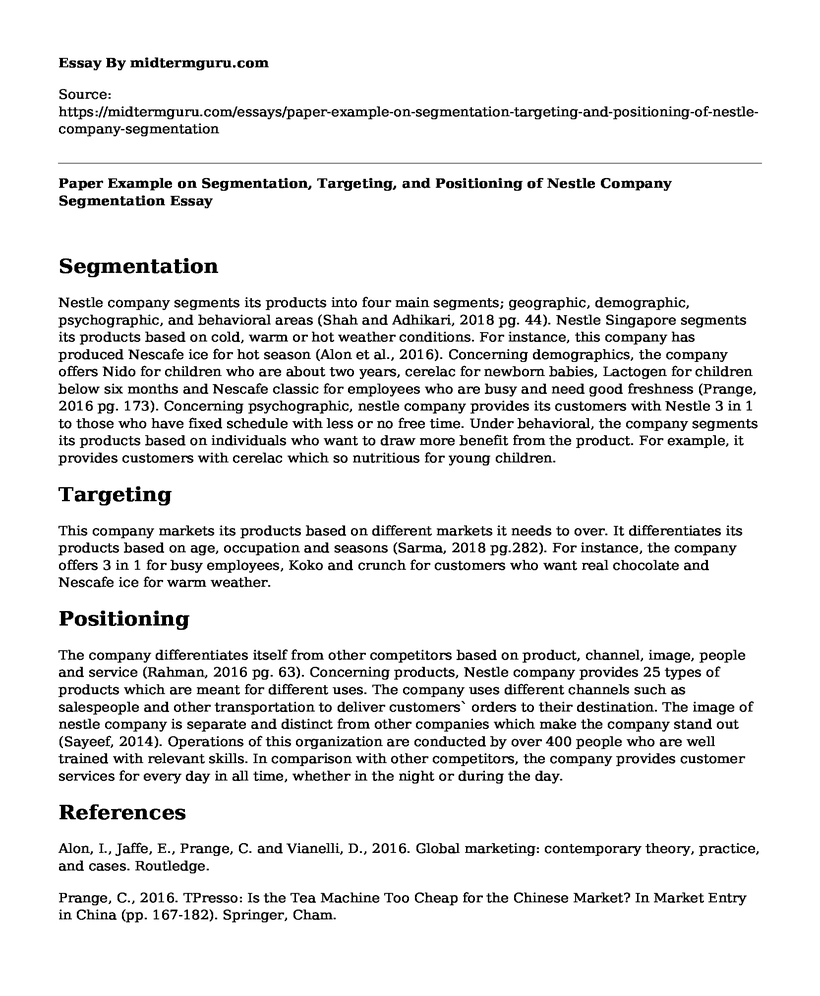Segmentation
Nestle company segments its products into four main segments; geographic, demographic, psychographic, and behavioral areas (Shah and Adhikari, 2018 pg. 44). Nestle Singapore segments its products based on cold, warm or hot weather conditions. For instance, this company has produced Nescafe ice for hot season (Alon et al., 2016). Concerning demographics, the company offers Nido for children who are about two years, cerelac for newborn babies, Lactogen for children below six months and Nescafe classic for employees who are busy and need good freshness (Prange, 2016 pg. 173). Concerning psychographic, nestle company provides its customers with Nestle 3 in 1 to those who have fixed schedule with less or no free time. Under behavioral, the company segments its products based on individuals who want to draw more benefit from the product. For example, it provides customers with cerelac which so nutritious for young children.
Targeting
This company markets its products based on different markets it needs to over. It differentiates its products based on age, occupation and seasons (Sarma, 2018 pg.282). For instance, the company offers 3 in 1 for busy employees, Koko and crunch for customers who want real chocolate and Nescafe ice for warm weather.
Positioning
The company differentiates itself from other competitors based on product, channel, image, people and service (Rahman, 2016 pg. 63). Concerning products, Nestle company provides 25 types of products which are meant for different uses. The company uses different channels such as salespeople and other transportation to deliver customers` orders to their destination. The image of nestle company is separate and distinct from other companies which make the company stand out (Sayeef, 2014). Operations of this organization are conducted by over 400 people who are well trained with relevant skills. In comparison with other competitors, the company provides customer services for every day in all time, whether in the night or during the day.
References
Alon, I., Jaffe, E., Prange, C. and Vianelli, D., 2016. Global marketing: contemporary theory, practice, and cases. Routledge.
Prange, C., 2016. TPresso: Is the Tea Machine Too Cheap for the Chinese Market? In Market Entry in China (pp. 167-182). Springer, Cham.
Rahman, K.M., 2016. Strategic Planning and Marketing Models. In Strategic Marketing Management in Asia: Case Studies and Lessons across Industries (pp. 59-110). Emerald Group Publishing Limited.
Sarma, S., 2018. Cultural Nuances in Changing Consumer Behavior: Lessons for Cultural Positioning. In Global Observations of the Influence of Culture on Consumer Buying Behavior (pp. 279-293). IGI Global.
Sayeef, Z.S., 2014. Nestle Bangladesh Ltd.
Shah, K. and Adhikari, A., 2018. The Neo- Middle Class: A Unique Opportunity for a Marketer. In Strategic Marketing Issues in Emerging Markets (pp. 41-47). Springer, Singapore
Cite this page
Paper Example on Segmentation, Targeting, and Positioning of Nestle Company Segmentation. (2022, Sep 15). Retrieved from https://midtermguru.com/essays/paper-example-on-segmentation-targeting-and-positioning-of-nestle-company-segmentation
If you are the original author of this essay and no longer wish to have it published on the midtermguru.com website, please click below to request its removal:
- Business Ethics Reflection Paper
- Essay on Informational Approach in Measuring Organizational Effectiveness
- A Discussion of Outsourcing and the Supply Chain
- Paper Example on Impact of Training and Development on Employee Efficiency
- Strategic Marketing Analysis - Paper Example
- Tussles Between the Management and the Deliveroo Couriers - Paper Example
- Walmart: The Multinational Giant in Retail Market - Essay Sample







